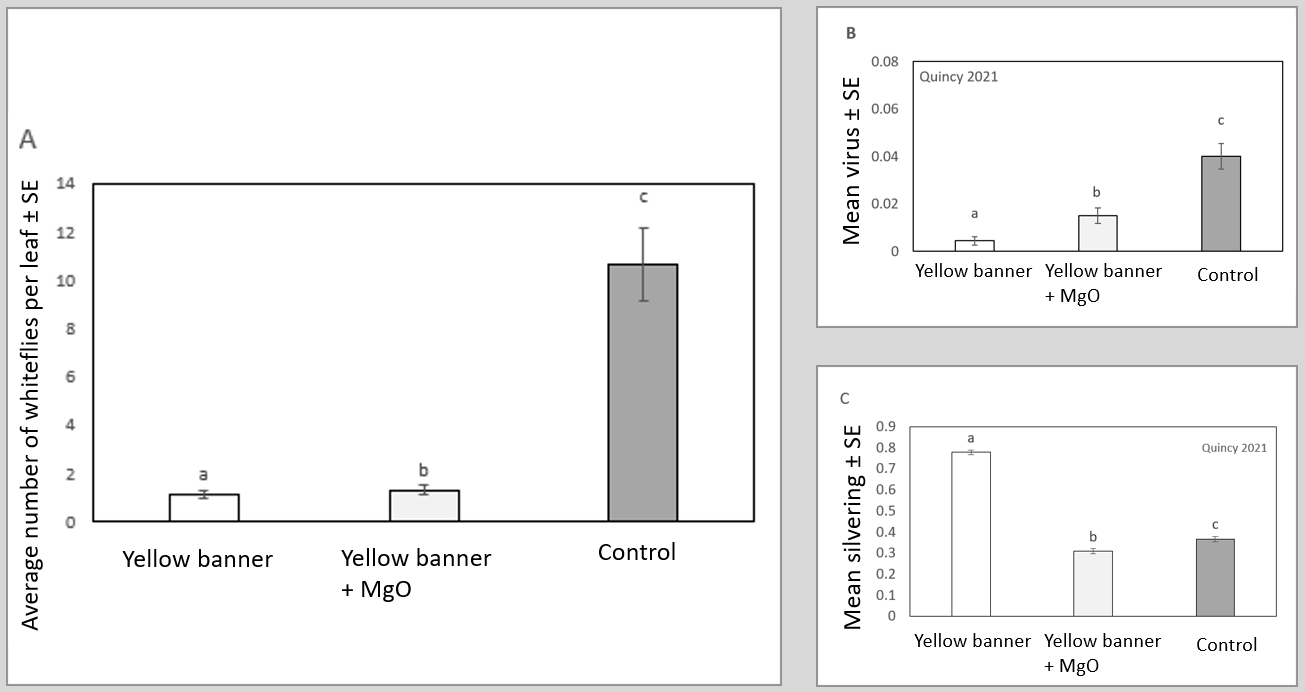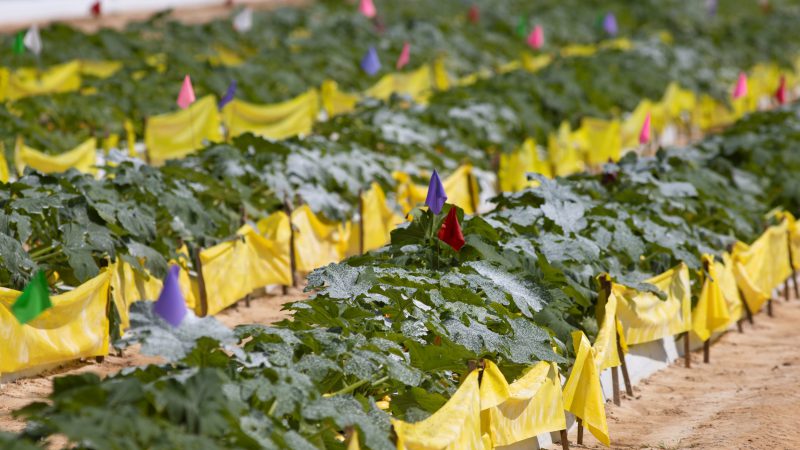Xavier Martini, Thomson Paris, UF/IFAS North Florida Research and Research and Education Center
Mass trapping is a control measure used to capture high numbers of a target pest to reduce their population in the field. Instead of killing the pest with an insecticide, the insect is attracted and captured in a trap. This method has the advantage of controlling target pests based on specific insect behavior, rather than relying solely on insecticides, which can create resistance challenges. In a greenhouse, mass trapping using yellow sticky traps has been successfully implemented to control whitefly populations. Whiteflies Bemisia tabaci Figure 1 (right) biotype B are of specific interest as resistances across diverse class of insecticides are widely reported in Florida. They are one of the most damaging pests in cucurbits and tomatoes in Florida, especially due to the diseases they transmit while feeding.
University of Florida Researchers recently experimented with sticky banners in a field situation to see if they could be used to control whiteflies in cucurbits. The yellow color is known to significantly attract a wide range of piercing insects including whiteflies. The yellow color used is in fact more attractive for the whiteflies than the green reflectance of the plant leaf. The yellow banners are sold in 12 inch rolls of 333 ft for $120 per roll. These rolls are easily installed in the field by attaching them to wooden stakes with a staple gun. We found that the banners were more efficient (i.e., they captured more whiteflies) if placed near the ground and close to the bed (Figure 2 below). The banners are quite durable, and outside of extreme climatic events (such as hurricanes/tropical storms), can be used for the whole growing season.
–
With yellow sticky banners erected along the bed of a squash field we found a significant reduction in the number of whitefly adults on the plant leaves (Figure 3A), as well as a reduction in the number of nymphs (not shown). We also found a reduction in the damage associated with whitefly feeding including silverleaf symptoms (Figure 3B). Importantly we also found less squash plants showing cucurbit crumple virus symptoms in the plots with the banners as compared to control (Figure 3C). We also evaluated the addition of magnesium oxide (MgO) , a powder with UV-reflectance properties, to increase the attraction of the yellow sticky banners . While plots with banners treated with MgO had similar number of whiteflies and silverleaf damage, the proportion of plants with cucurbit crumple virus symptoms was lower (fig. 3A, B and C).

Figure 3 Effect of the yellow sticky banners on (A) the number of whiteflies per squash leaf, (B) the proportion of plant with cucurbit crumple virus symptoms, and (C) the proportion of leaves with silvering symptoms. Trap + MgO: Magnesium oxide
–
Those yellow sticky rolls can also be used in association with conventional insecticides or with repellents such as kaolin clay and/or limonene. In this system, called “push-pull,’ the repellent pushes the whiteflies outside the plot whereas the banners attract and capture them on the outside. In this system we found that repellent and yellow sticky banners had an additive effect. The population of whiteflies were below what we obtained from insecticide alone. We collected data relative to beneficial pollinators and biological control agents, such as ladybeetles, and found no significant differences between the treatments with or without the banners.
The principal limitation of this method is the price, especially for larger fields. However, for small plots and artificial structures such as high tunnels, this method can be a good supplement to the current insecticidal control methods available for this pest.
- Sap Beetles are Not a Cause of Concern for Citrus but Katydids Are - October 4, 2024
- The Importance of Pollination for Seedless Watermelons and How to Enhance it - April 5, 2024
- New Perspectives for the Management of Invasive Air Potato Vine - November 17, 2023


